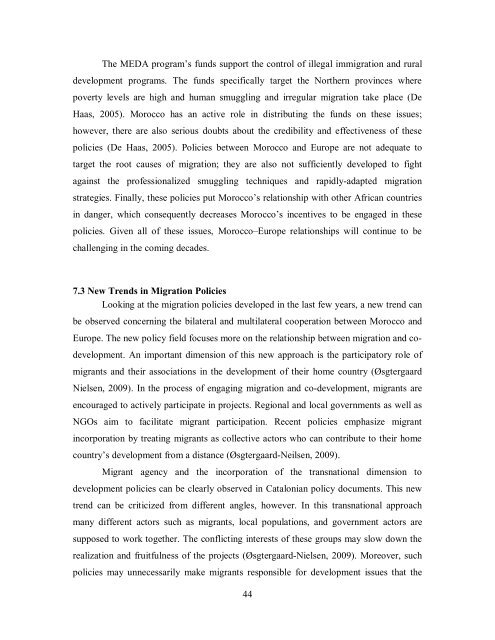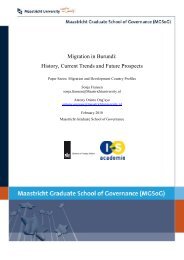Migration in Morocco: History, Current Trends and Future ... - MGSoG
Migration in Morocco: History, Current Trends and Future ... - MGSoG
Migration in Morocco: History, Current Trends and Future ... - MGSoG
Create successful ePaper yourself
Turn your PDF publications into a flip-book with our unique Google optimized e-Paper software.
The MEDA program’s funds support the control of illegal immigration <strong>and</strong> rural<br />
development programs. The funds specifically target the Northern prov<strong>in</strong>ces where<br />
poverty levels are high <strong>and</strong> human smuggl<strong>in</strong>g <strong>and</strong> irregular migration take place (De<br />
Haas, 2005). <strong>Morocco</strong> has an active role <strong>in</strong> distribut<strong>in</strong>g the funds on these issues;<br />
however, there are also serious doubts about the credibility <strong>and</strong> effectiveness of these<br />
policies (De Haas, 2005). Policies between <strong>Morocco</strong> <strong>and</strong> Europe are not adequate to<br />
target the root causes of migration; they are also not sufficiently developed to fight<br />
aga<strong>in</strong>st the professionalized smuggl<strong>in</strong>g techniques <strong>and</strong> rapidly-adapted migration<br />
strategies. F<strong>in</strong>ally, these policies put <strong>Morocco</strong>’s relationship with other African countries<br />
<strong>in</strong> danger, which consequently decreases <strong>Morocco</strong>’s <strong>in</strong>centives to be engaged <strong>in</strong> these<br />
policies. Given all of these issues, <strong>Morocco</strong>–Europe relationships will cont<strong>in</strong>ue to be<br />
challeng<strong>in</strong>g <strong>in</strong> the com<strong>in</strong>g decades.<br />
7.3 New <strong>Trends</strong> <strong>in</strong> <strong>Migration</strong> Policies<br />
Look<strong>in</strong>g at the migration policies developed <strong>in</strong> the last few years, a new trend can<br />
be observed concern<strong>in</strong>g the bilateral <strong>and</strong> multilateral cooperation between <strong>Morocco</strong> <strong>and</strong><br />
Europe. The new policy field focuses more on the relationship between migration <strong>and</strong> co-<br />
development. An important dimension of this new approach is the participatory role of<br />
migrants <strong>and</strong> their associations <strong>in</strong> the development of their home country (Øsgtergaard<br />
Nielsen, 2009). In the process of engag<strong>in</strong>g migration <strong>and</strong> co-development, migrants are<br />
encouraged to actively participate <strong>in</strong> projects. Regional <strong>and</strong> local governments as well as<br />
NGOs aim to facilitate migrant participation. Recent policies emphasize migrant<br />
<strong>in</strong>corporation by treat<strong>in</strong>g migrants as collective actors who can contribute to their home<br />
country’s development from a distance (Øsgtergaard-Neilsen, 2009).<br />
Migrant agency <strong>and</strong> the <strong>in</strong>corporation of the transnational dimension to<br />
development policies can be clearly observed <strong>in</strong> Catalonian policy documents. This new<br />
trend can be criticized from different angles, however. In this transnational approach<br />
many different actors such as migrants, local populations, <strong>and</strong> government actors are<br />
supposed to work together. The conflict<strong>in</strong>g <strong>in</strong>terests of these groups may slow down the<br />
realization <strong>and</strong> fruitfulness of the projects (Øsgtergaard-Nielsen, 2009). Moreover, such<br />
policies may unnecessarily make migrants responsible for development issues that the<br />
44



